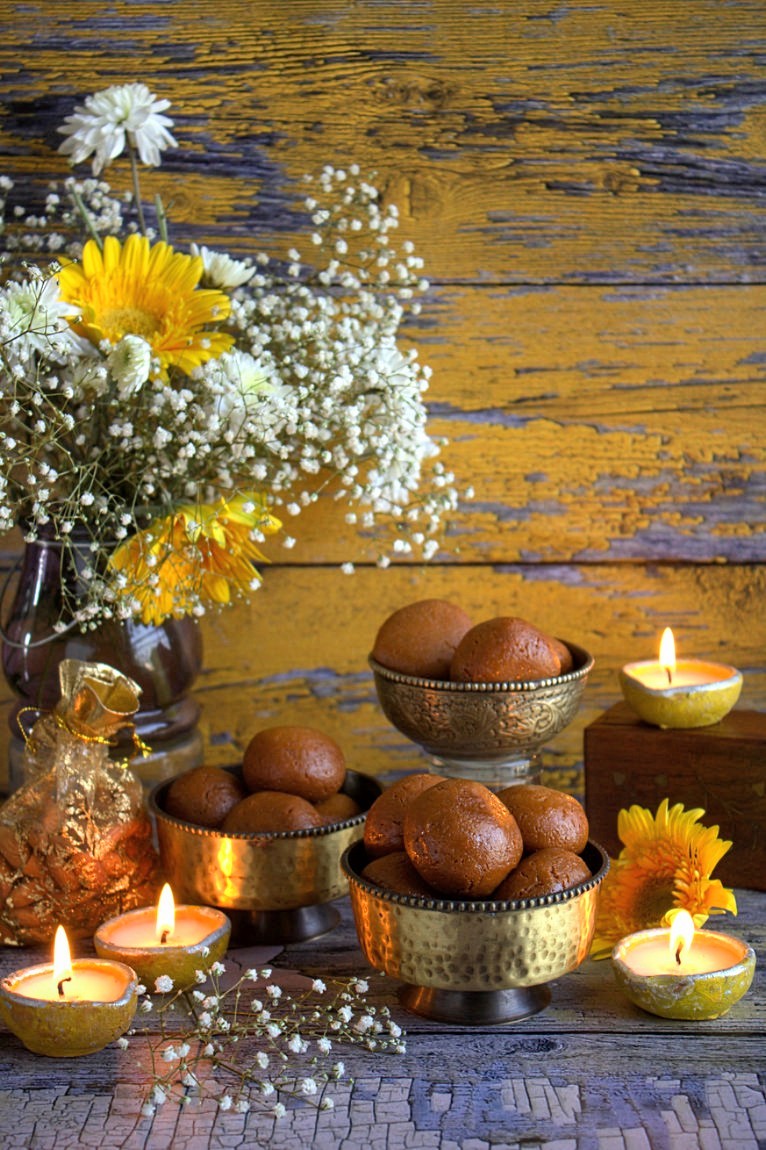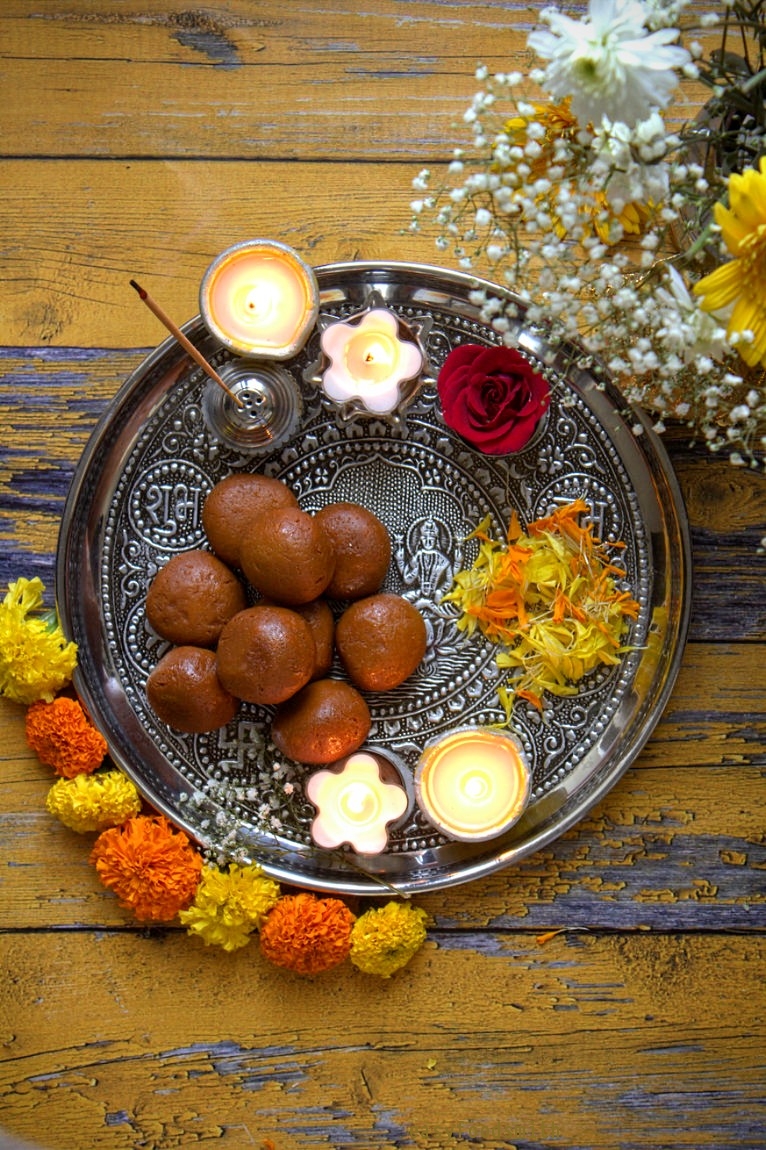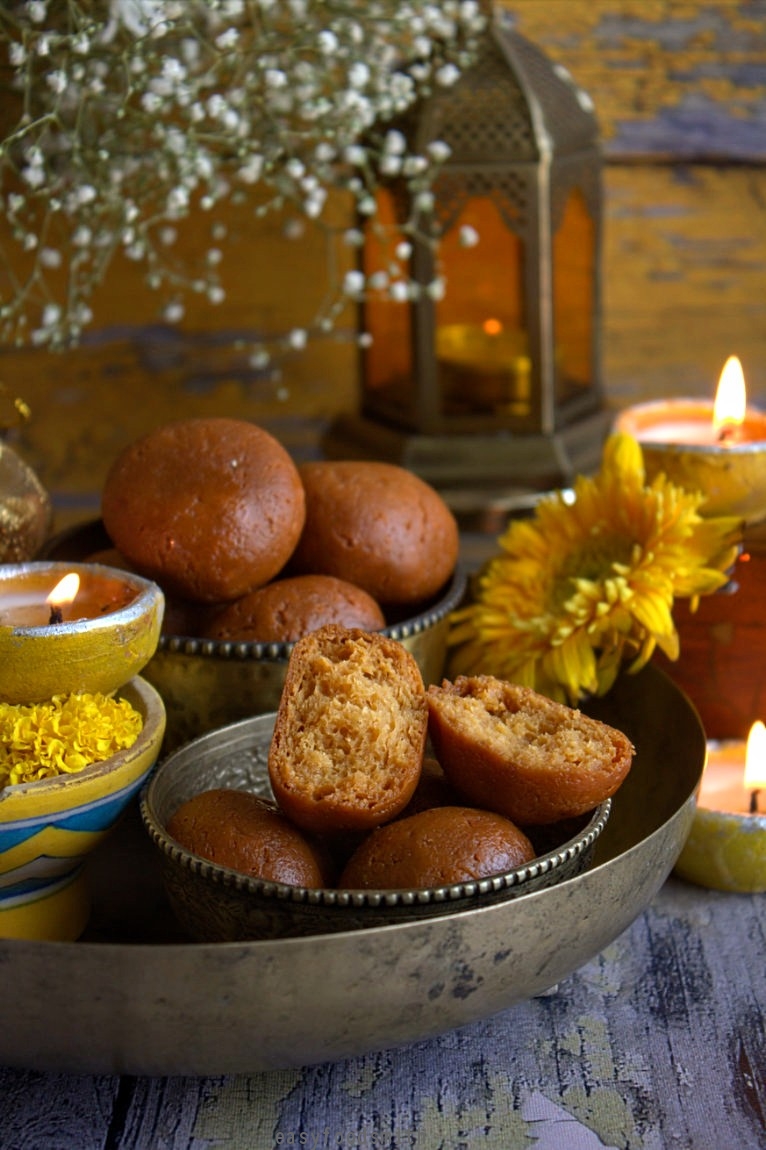Had it not been for the title of this post, I am sure you would have easily mistaken this dessert / mithai for gulab jamun. And you won’t be blamed for considering it a Gulab Jamun; the colour does give that impression. Just two very basic and simple ingredients go into making of this delicious Indian dessert that, I consider, to be the richer cousin of the famous Rasgulla. A couple of tweaks and you take the rasgulla to the next level and turn it into…Kheer Mohan.
Unlike rasgulla, which is soft and spongy, this one has a firm texture. Also, the syrup in case of rasgulla is watery while this one is thick-ish. The rasgulla tastes best when served chilled while kheer mohan tastes best when served warm or at room temperature.
Recipes that require fewer number of ingredients are mostly, in my view, the trickiest to make since you have very little in hand to bring out the flavours and make the taste of the dish reach its zenith. Kheer Mohan is a classic example of how just two ingredients can lead to something so tasty. The recipe is simple but it requires some skill and technique so I would label the ‘difficulty level’ as medium to may be medium–high especially for those who have never made rasgulla or rasmalai before. Keeping a few things in mind, you can ace the recipe, which is richly rewarding 😊
First is the making the cottage cheese or paneer or chhena. Do not add the whey or whatever curdling agent you intend to use, to the hot boiling milk. The milk needs to be stirred while you heat it. Once it is reaches boiling point, switch off heat, continue stirring (to prevent skin from forming on top of the milk) and then gradually add the lemon juice or vinegar to it, stirring all the while to ensure even mixing of the juice. Keeping stirring till the milk curdles and if not, gradually add a little more lemon juice or vinegar till the milk curdles and the greenish whey separates.
Second, the paneer needs to remain in the strainer for an hour. Over squeezing of whey from the paneer will lead to hard paneer balls and not enough squeezing will lead to moist softer balls that will break, upon cooking, in the sugar syrup. (this part is the trickiest I believe)
Third, over–kneading or mashing the paneer will release too much fat from the paneer and under kneading will lead to very grainy balls. So stop mashing / kneading when the cottage cheese begins to leave grease/ oil on your hands.
Fourth, the recipe requires a constant eye on the syrup while the paneer balls cook. Basically, it requires monitoring, patience and time. But so worth the time! And it is perfect recipe for celebrations and festivals coz that is the only time when one indulges in such recipes i.e. ones that require time and effort and taste absolutely brilliant!
I began sharing my Diwali dessert series with the Semolina Caramel Custard Pudding and I am ending it with a desi caramel mithai / caramel sweet.
Now that you have the knowledge of do’s and don’ts, let us begin with the recipe.
For Caramel
1 tbsp plus 1 tsp Sugar
¼ C Water
For Paneer
1 litre Cow Milk
1 tbsp Vinegar or Lime Juice (add more only if required)
1 C Ice cubes
1 tsp Corn flour or All Purpose Flour / maida
For Syrup
¾ – 1 C Sugar (adjust to taste, we prefer less sugar in our desserts so three fourth was fine with us)
3 C Water {initially, plus more, as required (in total I used a little over five cups of water)}
For making caramel
Caramelise sugar and once it has caramelised, immediately add one fourth cup of water. Stir well so that it is completely dissolved in the water. Switch off heat and set it aside.
For making paneer
Mix one tablespoon of vinegar or lemon juice to one tablespoon of water. Set aside.
Place a large sieve over a container and line the sieve with a muslin or cheese cloth. Set aside.
Pour milk in a pot and place it on heat. Keep stirring frequently while it comes to a boil. Switch off the heat and keep stirring the milk to prevent formation of skin over the hot milk.
Gradually add the vinegar to milk, while stirring the milk. You will observe the milk will begin to curdle. Keep stirring further till the whole milk curdles and leaves a greenish kind of whey behind. If not, add a little more vinegar or lemon juice till the milk curdles. Add ice and stir the contents.
Pour the contents over the lined sieve. Wash the paneer with water to remove sour taste of vinegar or lemon juice.
Bring the together the muslin or cheese cloth together and leave it on the sieve to drain the excess whey. Let it sit for an hour.
(You can reserve the whey for making dough or use it for making dal)
Gently squeeze the muslin cloth to get rid of any excess water. Decant the paneer on a large plate or thali
For Syrup
Add three cups of water and the sugar to a sauce pan. Place it on stovetop to bring the water to boil.
Meanwhile, start mashing the paneer with the base of your palm for three to five minutes. The time will depend on the quality of paneer. The basic rule is to mash till your hands just about, begin to turn greasy.
Add the flour and mix it well, gently, into the paneer. Divide the paneer in equal sized portions and small sized balls. You will need to gently press and roll the paneer between your palms and make smooth balls.
The water would have boiled by now. Add the caramel syrup we had made in the beginning. Ensure that the syrup is on a rolling boil, before you start adding the paneer balls to it.
Gradually add the balls to the sugar syrup, so that the water remains continuously on a rolling boil.
Cover and cook the paneer balls on medium heat for approximately twenty minutes. Half way down, gently flip them, being careful not to break them.
Reduce the heat and cook the balls covered on low heat now, for approximately 10 to 15 minutes. You will have to keep an eye on the syrup especially once it begins to thicken. If it looks too thick, add one fourth cup of water and allow the balls to cook covered again. How does one know that the syrup is thick? Well, you will see a lot of big white bubbles in the syrup and that is an indicator that the syrup is thickening and it is time to add a little water.
Keep checking every ten to fifteen minutes and keep of adding water gradually as required. It would probably require you to repeat this process five to six more times. Be sure to flip the balls every now and then, for even colouring.
The key here is to keep cooking the balls on low heat. Keep maintaining a slightly thick syrupy consistency till the balls are nicely coloured. (It took a total of one hour and forty minutes for the kheer mohan to get done to our liking)
Switch off heat and remove the cover. Cool completely before serving. It tastes best when served at room temperature or warm. Enjoy!
Yield – 12 pieces
Note – Store bought cottage cheese does not work well for this recipe. I suggest you make fresh paneer for this recipe i.e. made from scratch.
Note – It is pertinent to use cow milk.
Note – The quality of milk will lead to some differences in the quality of texture of the kheer mohan. It will also affect the cooking time therefore adjust it to anywhere to one hour thirty minutes, plus/minus ten minutes.
Note – Using cornflour is optional but I prefer using it since it helps bind together the paneer and reduces the probability of it breaking in the sugar syrup.
Note – The syrup for this mithai is on the thick side but it should not be too thick. If it is too thick, i.e. it is of the consistency that it is difficult to stir the contents, sprinkle a little water and switch on the heat. Stir gently and bring the water to a boil. Switch off heat immediately and keep the contents uncovered. Do the same when you intend to reheat, chilled ones, on stove top.
Thank you for your visit and see you soon again with another exciting recipe!








I have never had anything like this…so exotic, delicious and inviting.
An excellent recipe and brilliant pictures! So festive and inviting.
I love the foods that you present on your blog! They’re so unusual to me, and so interesting!
Thank you Jeff 🙂
These look delicious! I agree that sometimes the simplest recipes can be the trickiest.
Wow, this looks good. Rather different, and I want to try it. And yes, at first I DID think I was looking at gulab jamun! 🙂 Anyway, good stuff — thanks.
Thank you John. 🙂
You’re killing me with this one. Caramel and paneer – two of my most favorite things. This look irresistible and something I would absolutely love to try.
Aww…How I wish I could teleport them to you! 🙂